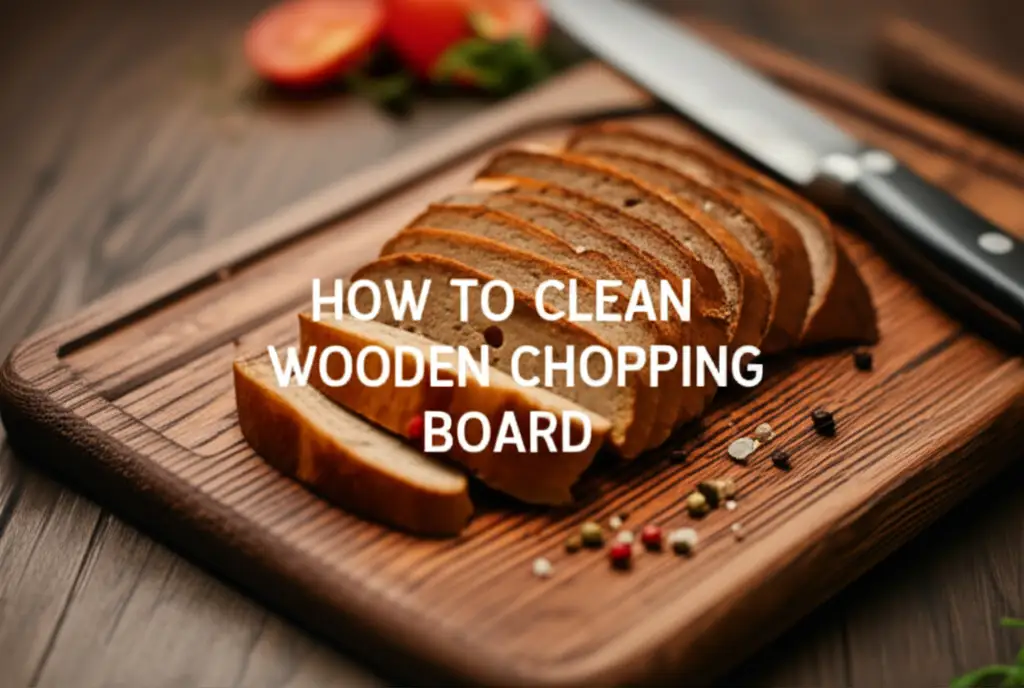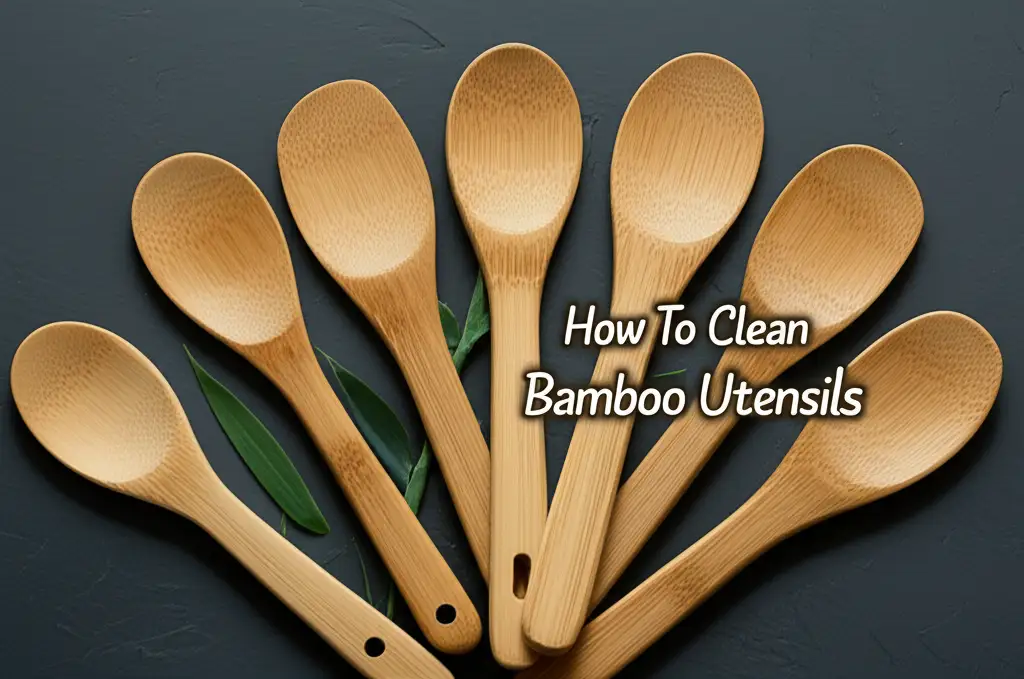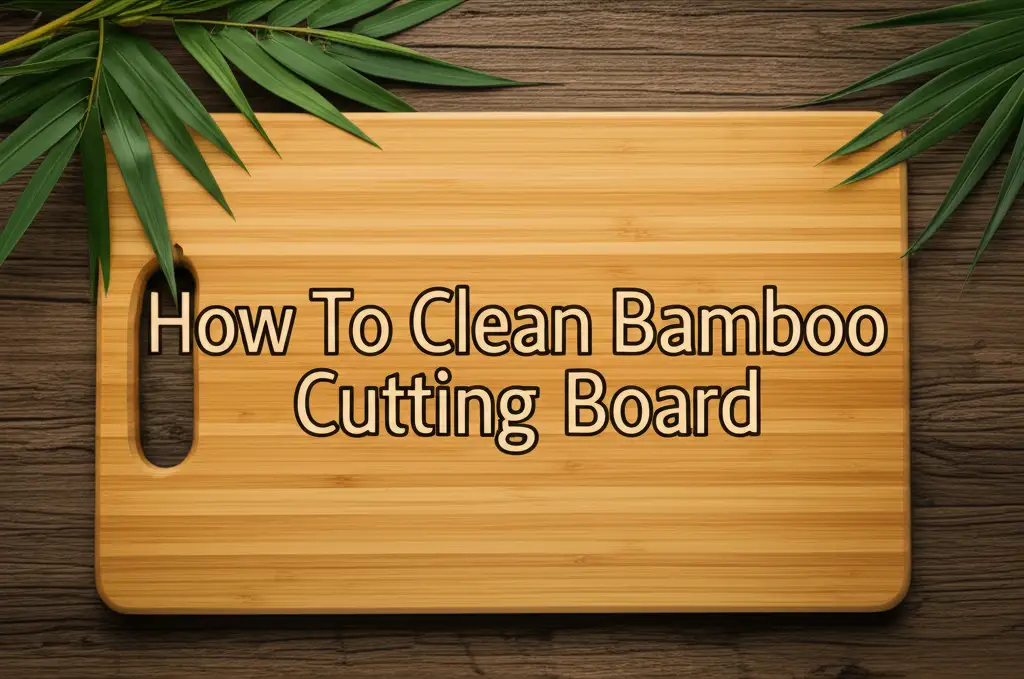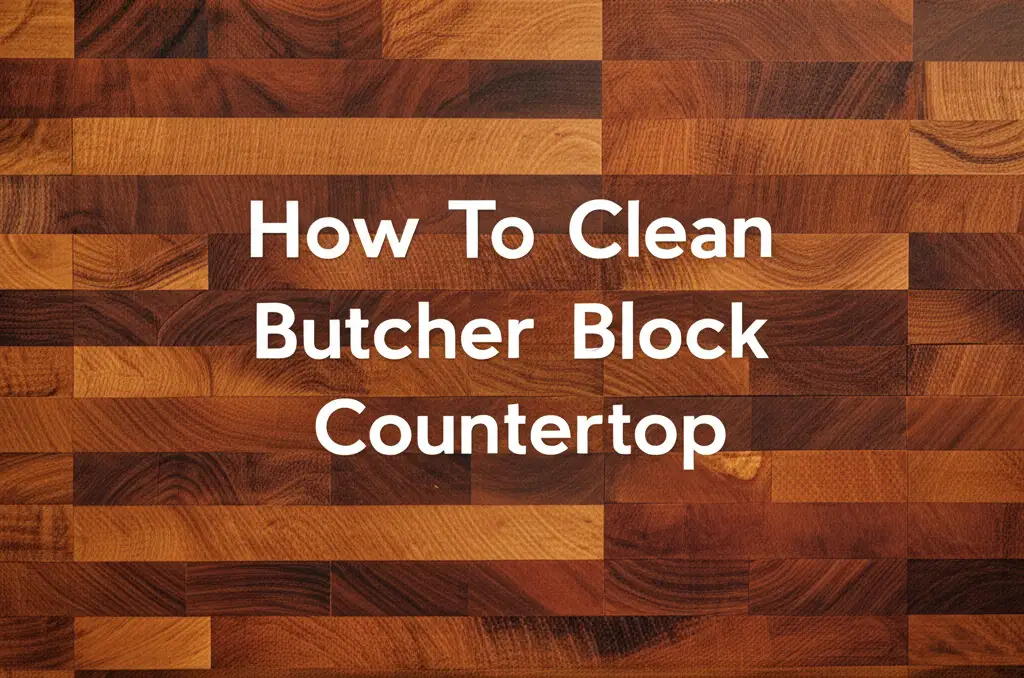· Kitchen Care · 15 min read
How To Clean Wooden Chopping Board

Clean Your Wooden Chopping Board: Essential Care Tips
Your wooden chopping board is a kitchen workhorse. It sees daily use, from slicing vegetables to prepping meats. Keeping it clean is not just about looks; it is crucial for food safety and the board’s lifespan. A well-maintained wooden chopping board is a joy to use. Ignoring its care can lead to bacteria buildup, odors, and even cracking.
This guide will show you how to clean wooden chopping boards effectively. We will cover daily cleaning routines and deep sanitization methods. You will learn how to tackle tough stains and remove unwanted odors. We will also share tips for proper maintenance, helping your board last for many years. Get ready to give your wooden chopping board the care it deserves.
Takeaway
- Clean your wooden chopping board immediately after each use.
- Use mild soap and warm water for daily cleaning.
- Sanitize regularly with natural solutions like lemon and salt or vinegar.
- Always dry your board thoroughly to prevent mold and warping.
- Oil your wooden board monthly to maintain its integrity and appearance.
To clean a wooden chopping board, wash it immediately after use with warm water and mild dish soap. Scrub the surface, rinse thoroughly, and then dry it completely with a clean towel. For deep cleaning or sanitizing, use natural remedies like lemon and salt or a diluted vinegar solution. Proper drying and regular oiling are key to its longevity.
Daily Cleaning for Wooden Chopping Boards
Cleaning your wooden chopping board after every use is the first step to proper maintenance. This prevents food particles from drying onto the surface. It also stops bacteria from growing. I always make sure to clean my board as soon as I finish cooking. This simple habit saves a lot of trouble later.
Start by scraping off any food scraps into the trash. Then, rinse the board under warm running water. Apply a few drops of mild dish soap to a clean sponge or dishcloth. Scrub both sides of the wooden chopping board thoroughly. Pay extra attention to any grooves or knife marks where food might hide. Do not use abrasive scrubbers, as these can damage the wood surface.
After scrubbing, rinse the board well under warm water until all soap residue is gone. It is important to remove all soap. Leftover soap can dry out the wood. Finally, dry the board immediately with a clean kitchen towel. Do not let it air dry on a flat surface. This can lead to warping or mold. Stand it on its edge or use a drying rack to allow air circulation around all sides. This helps your wooden chopping board dry evenly and quickly.
Deep Cleaning and Sanitizing Your Wooden Board
Regular daily cleaning is good, but deep cleaning is essential for hygiene. This is especially true after handling raw meats or strong-smelling foods. Deep cleaning helps to eliminate stubborn bacteria and odors. I find that natural methods work best for my wooden chopping board. They are effective and safe for food contact surfaces.
One popular method uses lemon and salt. First, sprinkle a generous amount of coarse salt over the entire surface of your board. Use half a lemon, cut side down, to scrub the salt into the wood. Squeeze the lemon gently as you scrub. The salt acts as a gentle abrasive, lifting food particles and stains. The lemon juice provides natural acidity, which helps to sanitize and deodorize. Let the mixture sit for 10-15 minutes. Then, scrape off the salt and rinse the board with warm water. Dry it immediately and thoroughly. This method works wonders for general sanitization and odor removal.
Another effective sanitizing agent is white vinegar. Vinegar is a natural disinfectant and deodorizer. Mix equal parts white vinegar and water in a spray bottle. Spray the solution generously over your wooden chopping board. Let it sit for a few minutes. You can also wipe it down with a cloth soaked in the solution. Vinegar is particularly effective at killing common bacteria. For handling raw meats, you must sanitize your wooden cutting board properly. Learn more about how to clean a wood cutting board after raw meat to ensure food safety.
After using vinegar, rinse the board with warm water and dry it completely. The vinegar smell will dissipate quickly as it dries. For tougher sanitization needs, especially if you suspect mold, a diluted hydrogen peroxide solution can be used. Mix 3% hydrogen peroxide with an equal amount of water. Apply it to the board, let it bubble for a few minutes, then rinse and dry. If you are ever worried about mold on other surfaces, you can explore how to clean mold with vinegar as well, since vinegar is a versatile cleaning agent.
Removing Stubborn Stains and Odors from Wood
Even with regular cleaning, wooden chopping boards can develop stubborn stains and absorb odors. This is common, especially after cutting colorful vegetables like beets or strong-smelling foods like garlic. Do not worry; there are effective ways to make your board look and smell fresh again. I have tried these methods myself, and they truly make a difference.
For many common stains, the lemon and salt method we discussed earlier is very effective. The abrasive nature of salt combined with the bleaching action of lemon juice helps lift discoloration. Spread coarse salt over the stained area. Rub it in with a lemon half. Let it sit for 10-15 minutes. Then, rinse and dry. This often works well for light food stains. For general wood stains around your home, knowing how to clean stains on wood can be very helpful.
Another powerful stain remover for wooden boards is baking soda. Baking soda is a mild abrasive and a natural deodorizer. Make a paste by mixing a few tablespoons of baking soda with a small amount of water. Apply this paste directly to the stain. Let it sit for about 20-30 minutes. Then, scrub the area gently with a brush or sponge. Rinse the board thoroughly with warm water. This method is excellent for dark stains or those from red wine or berries.
To combat persistent odors, baking soda is your best friend. After cleaning the board, sprinkle a layer of baking soda over the entire surface. Let it sit overnight. The baking soda will absorb the lingering smells. In the morning, brush off the baking soda and wipe the board clean. This works wonders for onion or garlic odors. Combining baking soda with lemon juice can also create a powerful deodorizing scrub. Remember, good air circulation after cleaning also helps prevent odors from setting in.
Preventing Mold and Bacteria Growth
A wooden chopping board can become a breeding ground for mold and bacteria if not cared for properly. Preventing this growth is vital for kitchen hygiene and the longevity of your board. The key steps are simple but require consistency. I learned early on that proper drying is the most crucial part.
The main culprit for mold growth is moisture. Never leave your wooden chopping board to soak in water. This allows water to penetrate the wood, leading to warping, cracking, and mold. After washing, always dry your board immediately and completely with a towel. Then, stand it on its side or in a drying rack. This allows air to circulate around all surfaces. Air drying flat on a counter traps moisture underneath. This creates a perfect environment for mold to thrive. Ensure your kitchen is well-ventilated, too.
Regular sanitization also plays a big role in preventing bacteria. Even if you cannot see them, bacteria can linger on the board surface. As discussed, vinegar solutions or lemon and salt scrubs are excellent for this. Make these deep cleaning routines a regular part of your board care, especially after preparing raw meat, poultry, or fish. These foods are more likely to carry harmful bacteria.
Inspect your wooden chopping board regularly for any signs of mold or dark spots. If you see small patches of mold, you can try cleaning them with a strong vinegar solution or a baking soda paste. Scrub the area thoroughly, rinse, and dry completely. If the mold is deep or widespread, it might be time to replace the board. This is for safety reasons. Regular maintenance helps you avoid this situation altogether.
Maintaining Your Wooden Chopping Board for Longevity
Proper maintenance extends the life and beauty of your wooden chopping board. Cleaning is only part of the equation. Oiling your board regularly is just as important. Think of it as moisturizing your skin; wood needs moisture to stay healthy. I make it a point to oil my board at least once a month, sometimes more often if I use it frequently.
The best type of oil for wooden chopping boards is food-grade mineral oil. It is safe, non-toxic, and penetrates the wood well. Avoid vegetable oils like olive or canola oil. These can go rancid over time, giving your board an unpleasant smell and sticky feel. To oil your board, make sure it is clean and completely dry. Apply a generous amount of mineral oil to a clean cloth. Rub the oil into the wood, working in the direction of the grain. Cover all surfaces, including the edges. You should see the wood absorbing the oil.
Let the oil soak into the wood for several hours, or even overnight. Some people like to let it sit for 24 hours. The longer it sits, the more it absorbs. After soaking, wipe off any excess oil with a clean, dry cloth. The board should feel smooth, not greasy. This oiling process hydrates the wood, prevents it from drying out, and helps it resist absorbing moisture and odors. It also gives the wood a rich, natural luster.
Besides oiling, proper storage is crucial. Store your wooden chopping board upright or on its edge. This allows air to circulate around it. Avoid storing it flat in a drawer or cabinet where moisture can get trapped. Also, never put your wooden chopping board in the dishwasher. The high heat and harsh detergents of a dishwasher will warp, crack, and eventually destroy the wood. Always hand wash and air dry. By following these simple maintenance steps, your wooden chopping board will serve you well for many years.
Common Mistakes to Avoid When Cleaning Wooden Boards
Caring for a wooden chopping board is straightforward, but some common mistakes can ruin it quickly. Knowing what not to do is just as important as knowing what to do. I have seen many good boards ruined by these errors, so I want to make sure you avoid them.
The most common mistake is soaking the wooden board in water. Many people leave their board in the sink filled with water. This is a big no-no. Wood is porous, and it will absorb a lot of water. This leads to swelling, warping, and cracking as the wood dries. Prolonged exposure to water also creates an ideal environment for bacteria and mold growth. Always wash your board quickly under running water. Do not let it sit in standing water.
Another serious mistake is putting your wooden chopping board in the dishwasher. Dishwashers use extremely hot water and aggressive detergents. This combination is devastating for wood. It strips away natural oils, causes rapid drying, and leads to severe cracking and warping. The high heat can also compromise the integrity of any glued seams on the board. Always hand wash your wooden board. This preserves its condition and extends its life.
Using harsh chemicals like bleach or strong abrasive cleaners is also a mistake. While bleach kills bacteria, it can also dry out and stain wood. It can leave a chemical residue that you do not want near food. Abrasive cleaners or scourers can scratch the wood surface, creating more crevices for bacteria to hide. Stick to mild dish soap, natural sanitizers like lemon and salt, or diluted vinegar. These are effective and safe for your board. Finally, not drying the board completely is a common oversight. Always towel dry and then stand it up to air dry thoroughly. These simple steps will keep your wooden chopping board in excellent condition for years.
Revitalizing an Old Wooden Chopping Board
Sometimes, a wooden chopping board looks beyond saving. It might be dull, scratched, or even have a few knife marks. Before you discard it, consider revitalizing it. Many old boards can be brought back to life with a little effort. I enjoy the process of restoring an old board; it feels very rewarding.
The first step in revitalizing an old board is deep cleaning. Use a vigorous scrub with lemon and salt or a baking soda paste to remove old stains and grime. You might need to repeat this process a few times. After cleaning, ensure the board is completely dry. This prepares it for the next step.
For deeply scratched or uneven surfaces, sanding can make a huge difference. Use fine-grit sandpaper (around 120-220 grit) to lightly sand the entire surface of the board. Sand in the direction of the wood grain. This smooths out knife marks and removes any raised grain. After sanding, wipe away all dust with a damp cloth, then dry the board thoroughly. Be gentle; you only want to smooth the surface, not remove too much wood.
Once the board is clean and smooth, it needs a good re-oiling. Apply several generous coats of food-grade mineral oil. Allow each coat to soak in for several hours before applying the next. You might notice the wood soaking up a lot of oil initially. This is a good sign; it means the wood was very dry. Continue applying oil until the wood feels saturated and looks rich. After the final coat, wipe off any excess oil. This revitalization process makes the board look almost new. It also makes it more resistant to future staining and moisture absorption. Giving an old board a second life is both sustainable and satisfying.
FAQ Section
Q1: Can I put my wooden chopping board in the dishwasher? No, you should never put your wooden chopping board in the dishwasher. The high heat and harsh detergents can cause the wood to warp, crack, and splinter. Dishwashers strip away the natural oils from the wood, leading to damage. Always hand wash your wooden board with mild soap and warm water.
Q2: How often should I oil my wooden chopping board? You should oil your wooden chopping board at least once a month. If you use your board frequently or wash it often, you might need to oil it every two to three weeks. Regular oiling prevents the wood from drying out. It also helps the board resist moisture, stains, and odors, extending its lifespan.
Q3: What kind of oil should I use for my wooden board? Use food-grade mineral oil for your wooden chopping board. This oil is non-toxic and will not go rancid. Avoid vegetable oils like olive, canola, or sunflower oil, as these can become sticky and develop an unpleasant smell over time. Mineral oil penetrates the wood well and helps keep it moisturized.
Q4: How do I remove deep knife marks from my board? You can remove deep knife marks by sanding your wooden chopping board. Use a fine-grit sandpaper (120-220 grit) and sand along the grain of the wood. This will smooth out the surface and reduce the appearance of scratches. After sanding, clean the board and re-oil it thoroughly to protect the wood.
Q5: Is it safe to use bleach on my wooden chopping board? No, it is generally not recommended to use bleach on your wooden chopping board. Bleach can dry out the wood, causing it to crack or discolor. It can also leave a chemical residue that is not safe for food contact. Stick to natural sanitizing agents like white vinegar or lemon and salt for cleaning and disinfection.
Q6: Why is my wooden board turning black? A wooden board turning black often indicates mold or mildew growth. This happens when the board is not dried properly after washing, allowing moisture to linger. It can also be from food residue left on the surface. To address it, deep clean with a vinegar solution or baking soda paste. Ensure thorough drying after every use.
Conclusion
Keeping your wooden chopping board clean is a simple but important task. It protects your family’s health and ensures your board lasts for many years. We have covered everything from daily washes to deep sanitization. You now know how to tackle stubborn stains and keep away unpleasant odors. Remember, consistent care makes all the difference.
Always wash your board immediately after use with mild soap and warm water. Dry it thoroughly and let it air dry completely standing on its edge. Sanitize regularly with natural solutions like lemon and salt or vinegar. Never put your wooden chopping board in the dishwasher. Oil your board monthly with food-grade mineral oil to keep it healthy and beautiful. By following these steps, your wooden chopping board will remain a safe and valued tool in your kitchen for a long time. Invest a little time in care, and your board will serve you well.
- wooden chopping board
- cutting board care
- sanitize wood
- wood maintenance
- kitchen hygiene




